MBA402: Risk Assessment Report of Trading.com - Ethics & Governance
VerifiedAdded on 2023/06/04
|15
|4047
|368
Report
AI Summary
This risk assessment report analyzes Trading.com, a company offering share investment courses, using a risk exposure calculator to identify pressure points related to growth, culture, and information management. The report highlights the high-pressure environment due to rapid growth, leading to lowered employment standards and inexperienced consultants. It also examines the competitive culture fostered by rewarding entrepreneurial risk-taking, potentially leading to internal conflicts and resistance to bad news from the executive level. Furthermore, the report discusses challenges in information management, including transaction complexity, gaps in diagnostic performance, and decentralized decision-making. The assessment underscores the need for Trading.com to address these risks to ensure sustainable long-term growth and maintain service quality. The document is available on Desklib, a platform offering study tools and solved assignments for students.
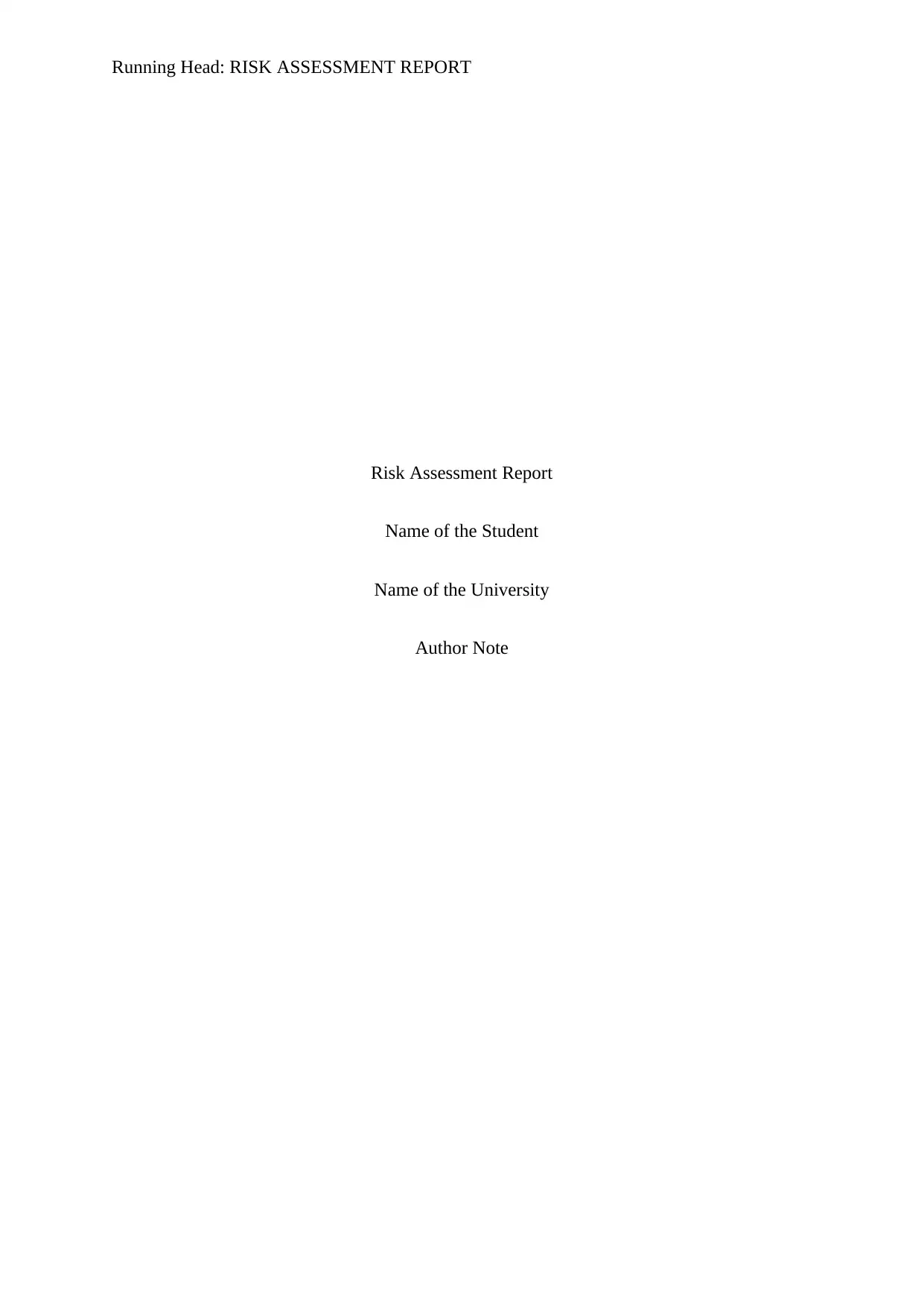
Running Head: RISK ASSESSMENT REPORT
Risk Assessment Report
Name of the Student
Name of the University
Author Note
Risk Assessment Report
Name of the Student
Name of the University
Author Note
Paraphrase This Document
Need a fresh take? Get an instant paraphrase of this document with our AI Paraphraser
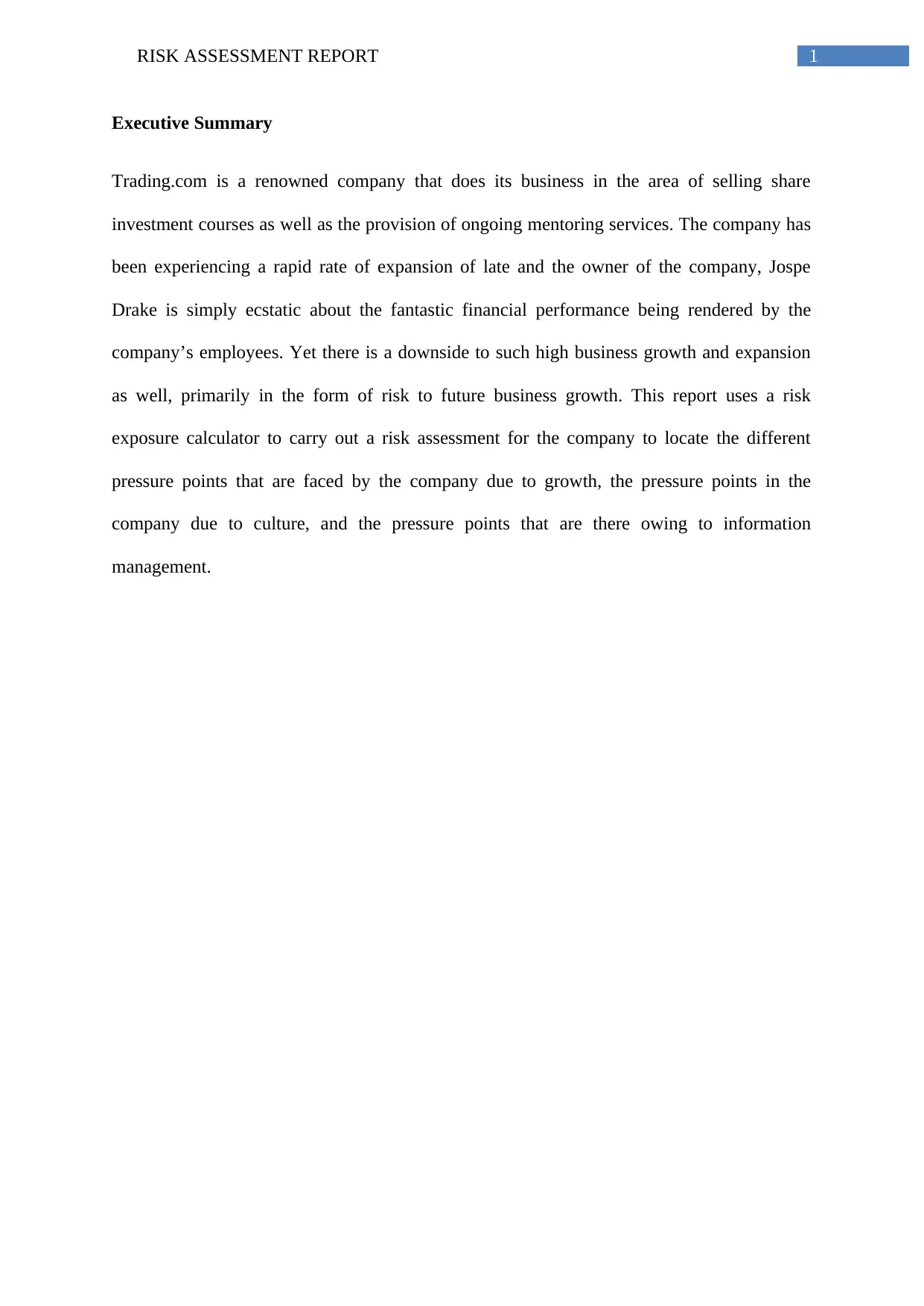
1RISK ASSESSMENT REPORT
Executive Summary
Trading.com is a renowned company that does its business in the area of selling share
investment courses as well as the provision of ongoing mentoring services. The company has
been experiencing a rapid rate of expansion of late and the owner of the company, Jospe
Drake is simply ecstatic about the fantastic financial performance being rendered by the
company’s employees. Yet there is a downside to such high business growth and expansion
as well, primarily in the form of risk to future business growth. This report uses a risk
exposure calculator to carry out a risk assessment for the company to locate the different
pressure points that are faced by the company due to growth, the pressure points in the
company due to culture, and the pressure points that are there owing to information
management.
Executive Summary
Trading.com is a renowned company that does its business in the area of selling share
investment courses as well as the provision of ongoing mentoring services. The company has
been experiencing a rapid rate of expansion of late and the owner of the company, Jospe
Drake is simply ecstatic about the fantastic financial performance being rendered by the
company’s employees. Yet there is a downside to such high business growth and expansion
as well, primarily in the form of risk to future business growth. This report uses a risk
exposure calculator to carry out a risk assessment for the company to locate the different
pressure points that are faced by the company due to growth, the pressure points in the
company due to culture, and the pressure points that are there owing to information
management.
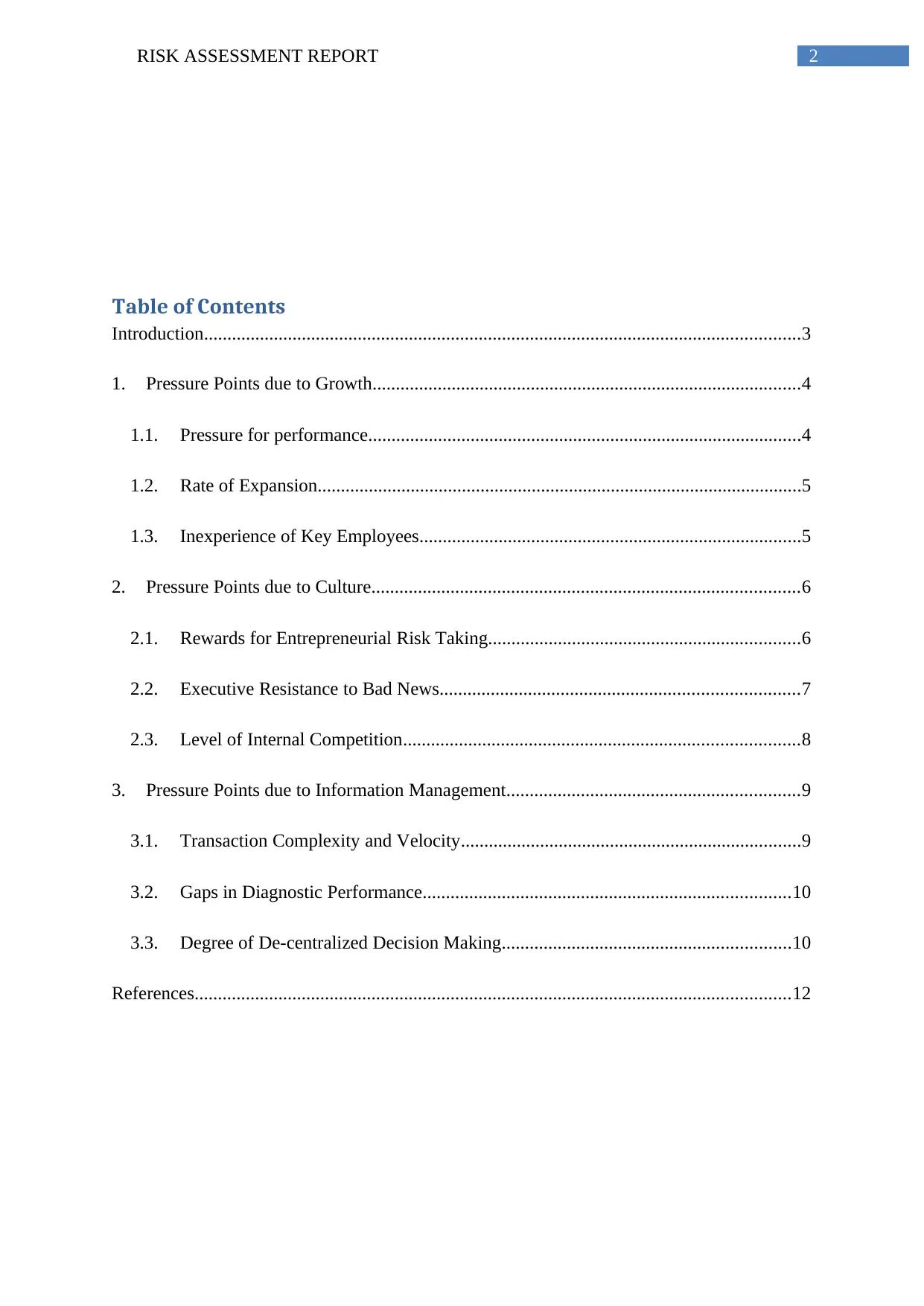
2RISK ASSESSMENT REPORT
Table of Contents
Introduction................................................................................................................................3
1. Pressure Points due to Growth............................................................................................4
1.1. Pressure for performance.............................................................................................4
1.2. Rate of Expansion........................................................................................................5
1.3. Inexperience of Key Employees..................................................................................5
2. Pressure Points due to Culture............................................................................................6
2.1. Rewards for Entrepreneurial Risk Taking...................................................................6
2.2. Executive Resistance to Bad News.............................................................................7
2.3. Level of Internal Competition.....................................................................................8
3. Pressure Points due to Information Management...............................................................9
3.1. Transaction Complexity and Velocity.........................................................................9
3.2. Gaps in Diagnostic Performance...............................................................................10
3.3. Degree of De-centralized Decision Making..............................................................10
References................................................................................................................................12
Table of Contents
Introduction................................................................................................................................3
1. Pressure Points due to Growth............................................................................................4
1.1. Pressure for performance.............................................................................................4
1.2. Rate of Expansion........................................................................................................5
1.3. Inexperience of Key Employees..................................................................................5
2. Pressure Points due to Culture............................................................................................6
2.1. Rewards for Entrepreneurial Risk Taking...................................................................6
2.2. Executive Resistance to Bad News.............................................................................7
2.3. Level of Internal Competition.....................................................................................8
3. Pressure Points due to Information Management...............................................................9
3.1. Transaction Complexity and Velocity.........................................................................9
3.2. Gaps in Diagnostic Performance...............................................................................10
3.3. Degree of De-centralized Decision Making..............................................................10
References................................................................................................................................12
⊘ This is a preview!⊘
Do you want full access?
Subscribe today to unlock all pages.

Trusted by 1+ million students worldwide
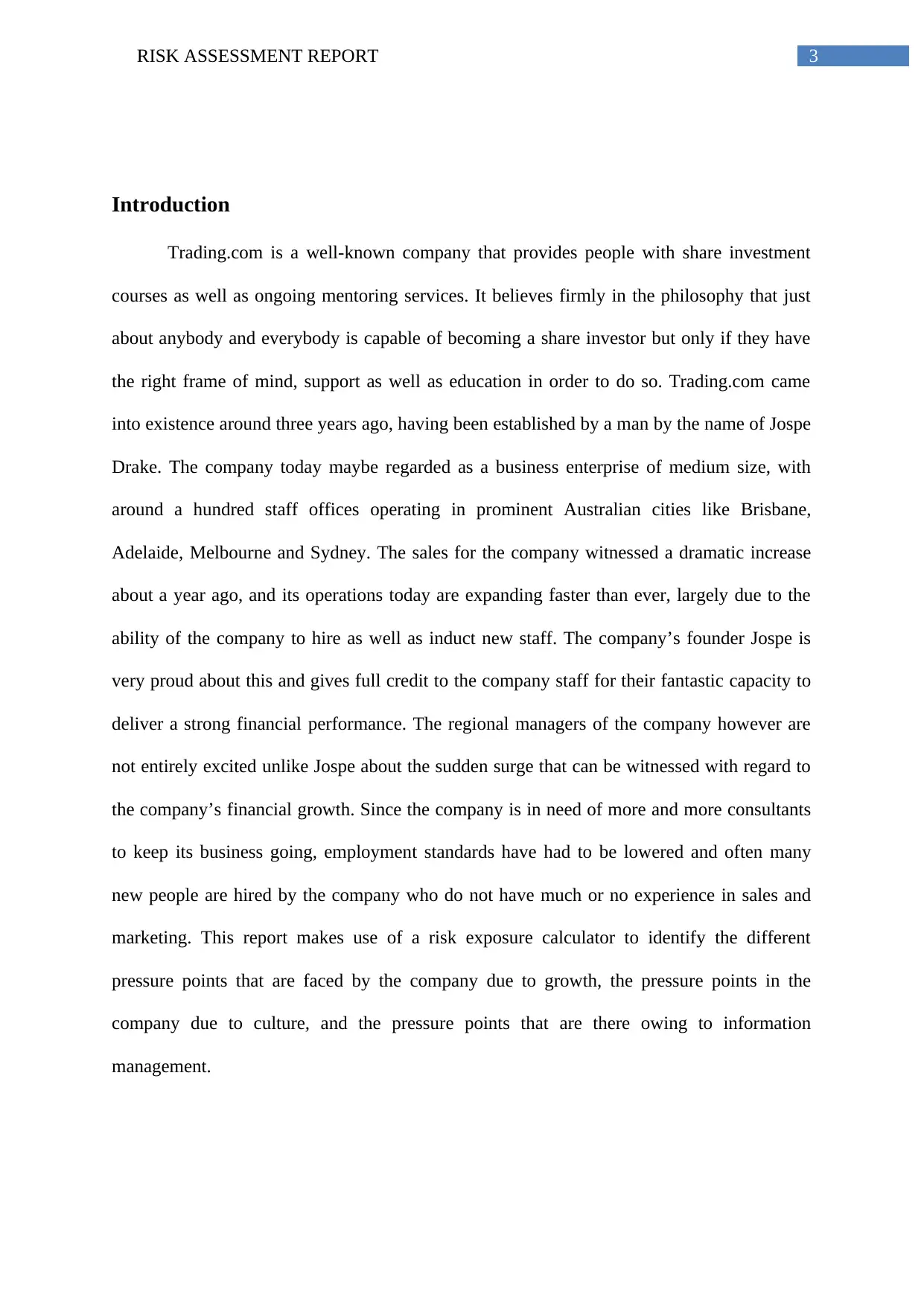
3RISK ASSESSMENT REPORT
Introduction
Trading.com is a well-known company that provides people with share investment
courses as well as ongoing mentoring services. It believes firmly in the philosophy that just
about anybody and everybody is capable of becoming a share investor but only if they have
the right frame of mind, support as well as education in order to do so. Trading.com came
into existence around three years ago, having been established by a man by the name of Jospe
Drake. The company today maybe regarded as a business enterprise of medium size, with
around a hundred staff offices operating in prominent Australian cities like Brisbane,
Adelaide, Melbourne and Sydney. The sales for the company witnessed a dramatic increase
about a year ago, and its operations today are expanding faster than ever, largely due to the
ability of the company to hire as well as induct new staff. The company’s founder Jospe is
very proud about this and gives full credit to the company staff for their fantastic capacity to
deliver a strong financial performance. The regional managers of the company however are
not entirely excited unlike Jospe about the sudden surge that can be witnessed with regard to
the company’s financial growth. Since the company is in need of more and more consultants
to keep its business going, employment standards have had to be lowered and often many
new people are hired by the company who do not have much or no experience in sales and
marketing. This report makes use of a risk exposure calculator to identify the different
pressure points that are faced by the company due to growth, the pressure points in the
company due to culture, and the pressure points that are there owing to information
management.
Introduction
Trading.com is a well-known company that provides people with share investment
courses as well as ongoing mentoring services. It believes firmly in the philosophy that just
about anybody and everybody is capable of becoming a share investor but only if they have
the right frame of mind, support as well as education in order to do so. Trading.com came
into existence around three years ago, having been established by a man by the name of Jospe
Drake. The company today maybe regarded as a business enterprise of medium size, with
around a hundred staff offices operating in prominent Australian cities like Brisbane,
Adelaide, Melbourne and Sydney. The sales for the company witnessed a dramatic increase
about a year ago, and its operations today are expanding faster than ever, largely due to the
ability of the company to hire as well as induct new staff. The company’s founder Jospe is
very proud about this and gives full credit to the company staff for their fantastic capacity to
deliver a strong financial performance. The regional managers of the company however are
not entirely excited unlike Jospe about the sudden surge that can be witnessed with regard to
the company’s financial growth. Since the company is in need of more and more consultants
to keep its business going, employment standards have had to be lowered and often many
new people are hired by the company who do not have much or no experience in sales and
marketing. This report makes use of a risk exposure calculator to identify the different
pressure points that are faced by the company due to growth, the pressure points in the
company due to culture, and the pressure points that are there owing to information
management.
Paraphrase This Document
Need a fresh take? Get an instant paraphrase of this document with our AI Paraphraser
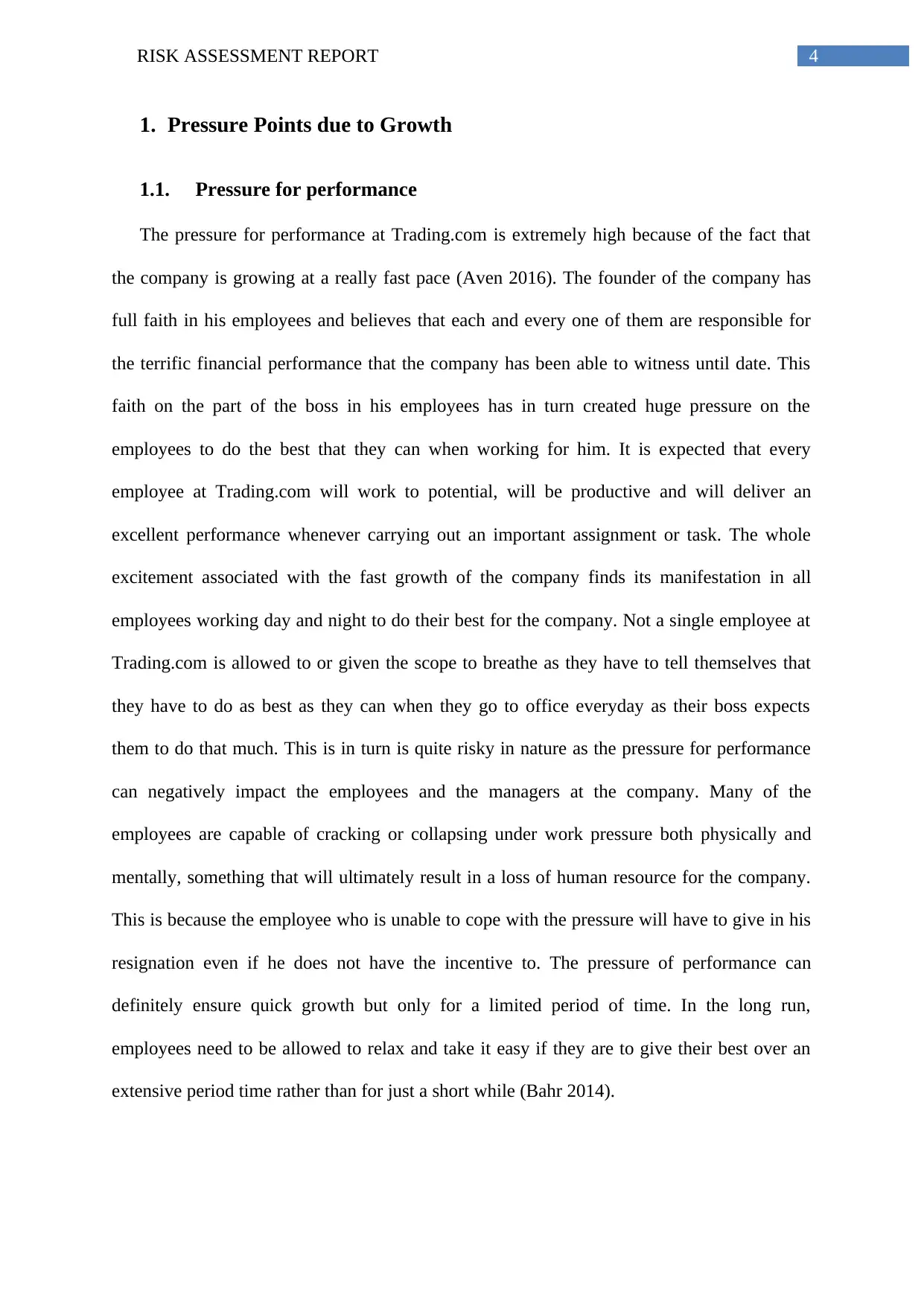
4RISK ASSESSMENT REPORT
1. Pressure Points due to Growth
1.1. Pressure for performance
The pressure for performance at Trading.com is extremely high because of the fact that
the company is growing at a really fast pace (Aven 2016). The founder of the company has
full faith in his employees and believes that each and every one of them are responsible for
the terrific financial performance that the company has been able to witness until date. This
faith on the part of the boss in his employees has in turn created huge pressure on the
employees to do the best that they can when working for him. It is expected that every
employee at Trading.com will work to potential, will be productive and will deliver an
excellent performance whenever carrying out an important assignment or task. The whole
excitement associated with the fast growth of the company finds its manifestation in all
employees working day and night to do their best for the company. Not a single employee at
Trading.com is allowed to or given the scope to breathe as they have to tell themselves that
they have to do as best as they can when they go to office everyday as their boss expects
them to do that much. This is in turn is quite risky in nature as the pressure for performance
can negatively impact the employees and the managers at the company. Many of the
employees are capable of cracking or collapsing under work pressure both physically and
mentally, something that will ultimately result in a loss of human resource for the company.
This is because the employee who is unable to cope with the pressure will have to give in his
resignation even if he does not have the incentive to. The pressure of performance can
definitely ensure quick growth but only for a limited period of time. In the long run,
employees need to be allowed to relax and take it easy if they are to give their best over an
extensive period time rather than for just a short while (Bahr 2014).
1. Pressure Points due to Growth
1.1. Pressure for performance
The pressure for performance at Trading.com is extremely high because of the fact that
the company is growing at a really fast pace (Aven 2016). The founder of the company has
full faith in his employees and believes that each and every one of them are responsible for
the terrific financial performance that the company has been able to witness until date. This
faith on the part of the boss in his employees has in turn created huge pressure on the
employees to do the best that they can when working for him. It is expected that every
employee at Trading.com will work to potential, will be productive and will deliver an
excellent performance whenever carrying out an important assignment or task. The whole
excitement associated with the fast growth of the company finds its manifestation in all
employees working day and night to do their best for the company. Not a single employee at
Trading.com is allowed to or given the scope to breathe as they have to tell themselves that
they have to do as best as they can when they go to office everyday as their boss expects
them to do that much. This is in turn is quite risky in nature as the pressure for performance
can negatively impact the employees and the managers at the company. Many of the
employees are capable of cracking or collapsing under work pressure both physically and
mentally, something that will ultimately result in a loss of human resource for the company.
This is because the employee who is unable to cope with the pressure will have to give in his
resignation even if he does not have the incentive to. The pressure of performance can
definitely ensure quick growth but only for a limited period of time. In the long run,
employees need to be allowed to relax and take it easy if they are to give their best over an
extensive period time rather than for just a short while (Bahr 2014).
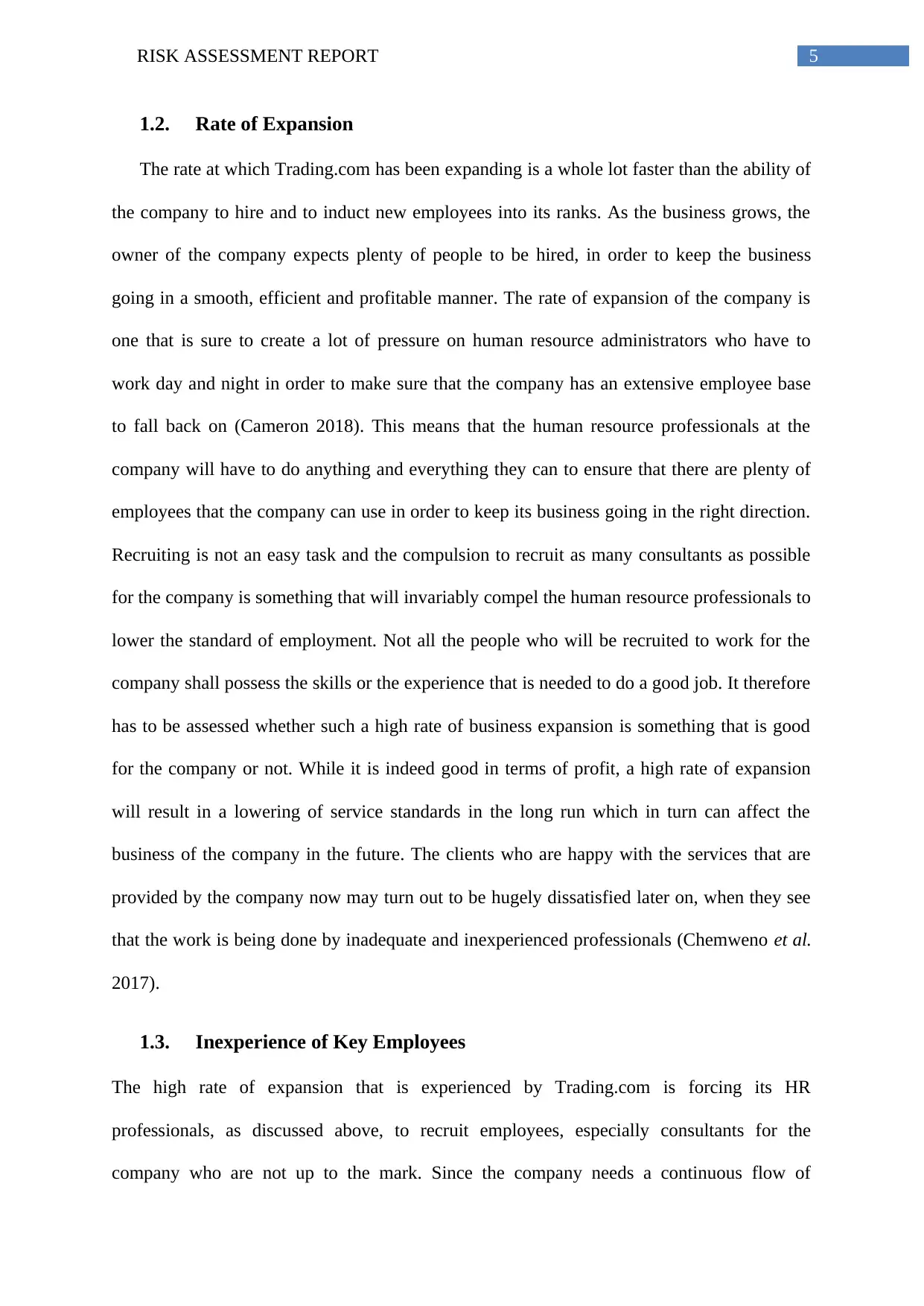
5RISK ASSESSMENT REPORT
1.2. Rate of Expansion
The rate at which Trading.com has been expanding is a whole lot faster than the ability of
the company to hire and to induct new employees into its ranks. As the business grows, the
owner of the company expects plenty of people to be hired, in order to keep the business
going in a smooth, efficient and profitable manner. The rate of expansion of the company is
one that is sure to create a lot of pressure on human resource administrators who have to
work day and night in order to make sure that the company has an extensive employee base
to fall back on (Cameron 2018). This means that the human resource professionals at the
company will have to do anything and everything they can to ensure that there are plenty of
employees that the company can use in order to keep its business going in the right direction.
Recruiting is not an easy task and the compulsion to recruit as many consultants as possible
for the company is something that will invariably compel the human resource professionals to
lower the standard of employment. Not all the people who will be recruited to work for the
company shall possess the skills or the experience that is needed to do a good job. It therefore
has to be assessed whether such a high rate of business expansion is something that is good
for the company or not. While it is indeed good in terms of profit, a high rate of expansion
will result in a lowering of service standards in the long run which in turn can affect the
business of the company in the future. The clients who are happy with the services that are
provided by the company now may turn out to be hugely dissatisfied later on, when they see
that the work is being done by inadequate and inexperienced professionals (Chemweno et al.
2017).
1.3. Inexperience of Key Employees
The high rate of expansion that is experienced by Trading.com is forcing its HR
professionals, as discussed above, to recruit employees, especially consultants for the
company who are not up to the mark. Since the company needs a continuous flow of
1.2. Rate of Expansion
The rate at which Trading.com has been expanding is a whole lot faster than the ability of
the company to hire and to induct new employees into its ranks. As the business grows, the
owner of the company expects plenty of people to be hired, in order to keep the business
going in a smooth, efficient and profitable manner. The rate of expansion of the company is
one that is sure to create a lot of pressure on human resource administrators who have to
work day and night in order to make sure that the company has an extensive employee base
to fall back on (Cameron 2018). This means that the human resource professionals at the
company will have to do anything and everything they can to ensure that there are plenty of
employees that the company can use in order to keep its business going in the right direction.
Recruiting is not an easy task and the compulsion to recruit as many consultants as possible
for the company is something that will invariably compel the human resource professionals to
lower the standard of employment. Not all the people who will be recruited to work for the
company shall possess the skills or the experience that is needed to do a good job. It therefore
has to be assessed whether such a high rate of business expansion is something that is good
for the company or not. While it is indeed good in terms of profit, a high rate of expansion
will result in a lowering of service standards in the long run which in turn can affect the
business of the company in the future. The clients who are happy with the services that are
provided by the company now may turn out to be hugely dissatisfied later on, when they see
that the work is being done by inadequate and inexperienced professionals (Chemweno et al.
2017).
1.3. Inexperience of Key Employees
The high rate of expansion that is experienced by Trading.com is forcing its HR
professionals, as discussed above, to recruit employees, especially consultants for the
company who are not up to the mark. Since the company needs a continuous flow of
⊘ This is a preview!⊘
Do you want full access?
Subscribe today to unlock all pages.

Trusted by 1+ million students worldwide
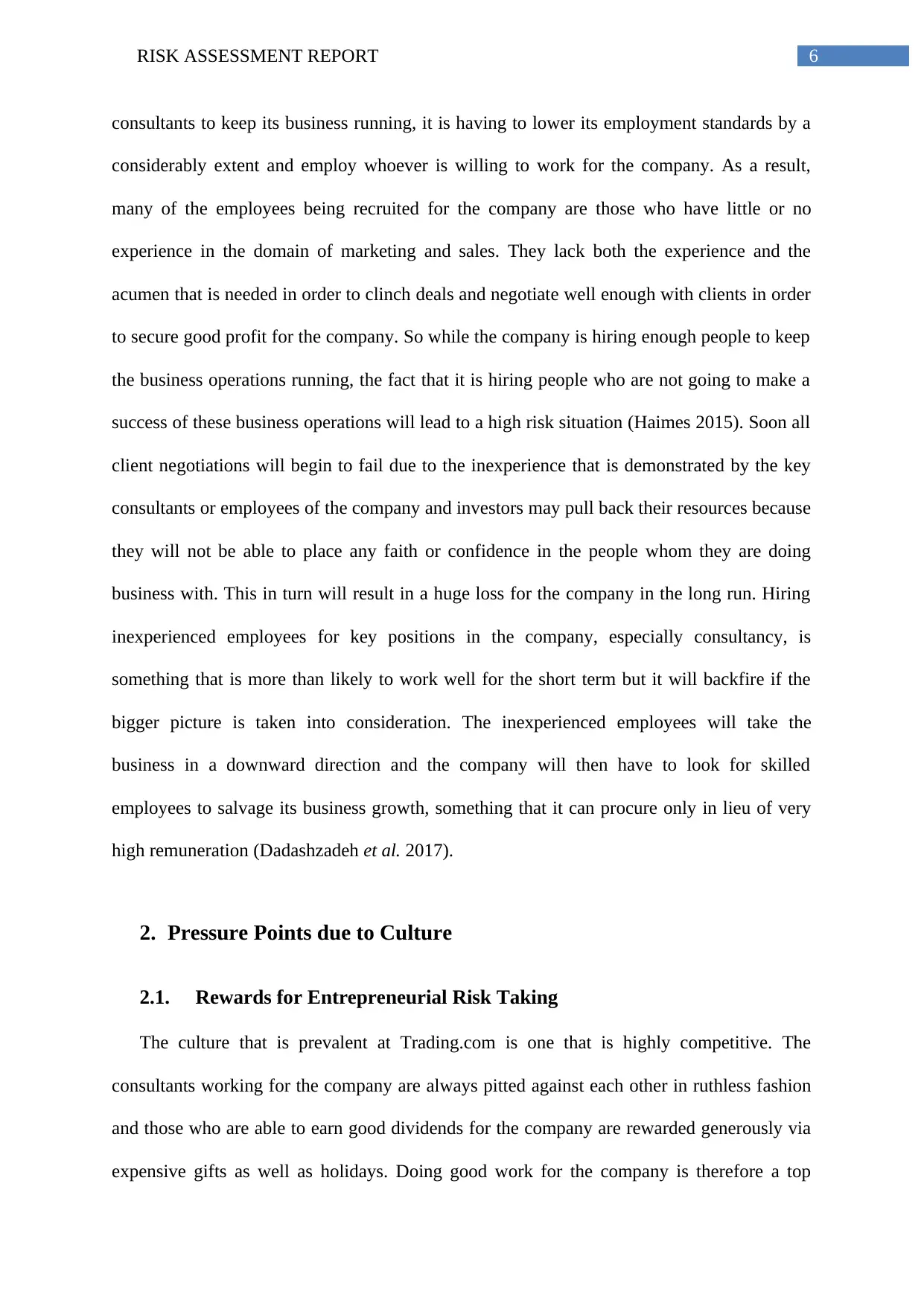
6RISK ASSESSMENT REPORT
consultants to keep its business running, it is having to lower its employment standards by a
considerably extent and employ whoever is willing to work for the company. As a result,
many of the employees being recruited for the company are those who have little or no
experience in the domain of marketing and sales. They lack both the experience and the
acumen that is needed in order to clinch deals and negotiate well enough with clients in order
to secure good profit for the company. So while the company is hiring enough people to keep
the business operations running, the fact that it is hiring people who are not going to make a
success of these business operations will lead to a high risk situation (Haimes 2015). Soon all
client negotiations will begin to fail due to the inexperience that is demonstrated by the key
consultants or employees of the company and investors may pull back their resources because
they will not be able to place any faith or confidence in the people whom they are doing
business with. This in turn will result in a huge loss for the company in the long run. Hiring
inexperienced employees for key positions in the company, especially consultancy, is
something that is more than likely to work well for the short term but it will backfire if the
bigger picture is taken into consideration. The inexperienced employees will take the
business in a downward direction and the company will then have to look for skilled
employees to salvage its business growth, something that it can procure only in lieu of very
high remuneration (Dadashzadeh et al. 2017).
2. Pressure Points due to Culture
2.1. Rewards for Entrepreneurial Risk Taking
The culture that is prevalent at Trading.com is one that is highly competitive. The
consultants working for the company are always pitted against each other in ruthless fashion
and those who are able to earn good dividends for the company are rewarded generously via
expensive gifts as well as holidays. Doing good work for the company is therefore a top
consultants to keep its business running, it is having to lower its employment standards by a
considerably extent and employ whoever is willing to work for the company. As a result,
many of the employees being recruited for the company are those who have little or no
experience in the domain of marketing and sales. They lack both the experience and the
acumen that is needed in order to clinch deals and negotiate well enough with clients in order
to secure good profit for the company. So while the company is hiring enough people to keep
the business operations running, the fact that it is hiring people who are not going to make a
success of these business operations will lead to a high risk situation (Haimes 2015). Soon all
client negotiations will begin to fail due to the inexperience that is demonstrated by the key
consultants or employees of the company and investors may pull back their resources because
they will not be able to place any faith or confidence in the people whom they are doing
business with. This in turn will result in a huge loss for the company in the long run. Hiring
inexperienced employees for key positions in the company, especially consultancy, is
something that is more than likely to work well for the short term but it will backfire if the
bigger picture is taken into consideration. The inexperienced employees will take the
business in a downward direction and the company will then have to look for skilled
employees to salvage its business growth, something that it can procure only in lieu of very
high remuneration (Dadashzadeh et al. 2017).
2. Pressure Points due to Culture
2.1. Rewards for Entrepreneurial Risk Taking
The culture that is prevalent at Trading.com is one that is highly competitive. The
consultants working for the company are always pitted against each other in ruthless fashion
and those who are able to earn good dividends for the company are rewarded generously via
expensive gifts as well as holidays. Doing good work for the company is therefore a top
Paraphrase This Document
Need a fresh take? Get an instant paraphrase of this document with our AI Paraphraser
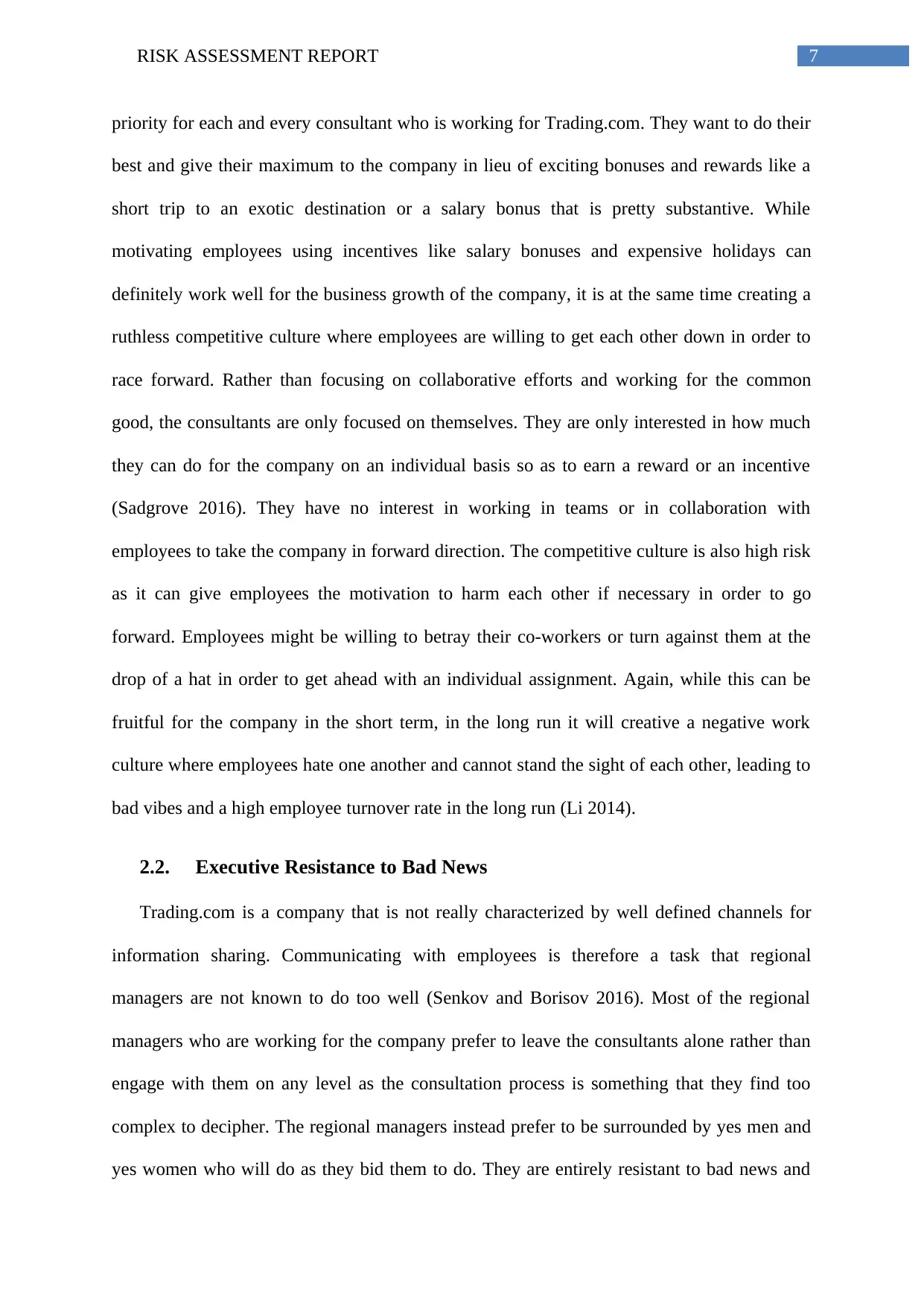
7RISK ASSESSMENT REPORT
priority for each and every consultant who is working for Trading.com. They want to do their
best and give their maximum to the company in lieu of exciting bonuses and rewards like a
short trip to an exotic destination or a salary bonus that is pretty substantive. While
motivating employees using incentives like salary bonuses and expensive holidays can
definitely work well for the business growth of the company, it is at the same time creating a
ruthless competitive culture where employees are willing to get each other down in order to
race forward. Rather than focusing on collaborative efforts and working for the common
good, the consultants are only focused on themselves. They are only interested in how much
they can do for the company on an individual basis so as to earn a reward or an incentive
(Sadgrove 2016). They have no interest in working in teams or in collaboration with
employees to take the company in forward direction. The competitive culture is also high risk
as it can give employees the motivation to harm each other if necessary in order to go
forward. Employees might be willing to betray their co-workers or turn against them at the
drop of a hat in order to get ahead with an individual assignment. Again, while this can be
fruitful for the company in the short term, in the long run it will creative a negative work
culture where employees hate one another and cannot stand the sight of each other, leading to
bad vibes and a high employee turnover rate in the long run (Li 2014).
2.2. Executive Resistance to Bad News
Trading.com is a company that is not really characterized by well defined channels for
information sharing. Communicating with employees is therefore a task that regional
managers are not known to do too well (Senkov and Borisov 2016). Most of the regional
managers who are working for the company prefer to leave the consultants alone rather than
engage with them on any level as the consultation process is something that they find too
complex to decipher. The regional managers instead prefer to be surrounded by yes men and
yes women who will do as they bid them to do. They are entirely resistant to bad news and
priority for each and every consultant who is working for Trading.com. They want to do their
best and give their maximum to the company in lieu of exciting bonuses and rewards like a
short trip to an exotic destination or a salary bonus that is pretty substantive. While
motivating employees using incentives like salary bonuses and expensive holidays can
definitely work well for the business growth of the company, it is at the same time creating a
ruthless competitive culture where employees are willing to get each other down in order to
race forward. Rather than focusing on collaborative efforts and working for the common
good, the consultants are only focused on themselves. They are only interested in how much
they can do for the company on an individual basis so as to earn a reward or an incentive
(Sadgrove 2016). They have no interest in working in teams or in collaboration with
employees to take the company in forward direction. The competitive culture is also high risk
as it can give employees the motivation to harm each other if necessary in order to go
forward. Employees might be willing to betray their co-workers or turn against them at the
drop of a hat in order to get ahead with an individual assignment. Again, while this can be
fruitful for the company in the short term, in the long run it will creative a negative work
culture where employees hate one another and cannot stand the sight of each other, leading to
bad vibes and a high employee turnover rate in the long run (Li 2014).
2.2. Executive Resistance to Bad News
Trading.com is a company that is not really characterized by well defined channels for
information sharing. Communicating with employees is therefore a task that regional
managers are not known to do too well (Senkov and Borisov 2016). Most of the regional
managers who are working for the company prefer to leave the consultants alone rather than
engage with them on any level as the consultation process is something that they find too
complex to decipher. The regional managers instead prefer to be surrounded by yes men and
yes women who will do as they bid them to do. They are entirely resistant to bad news and
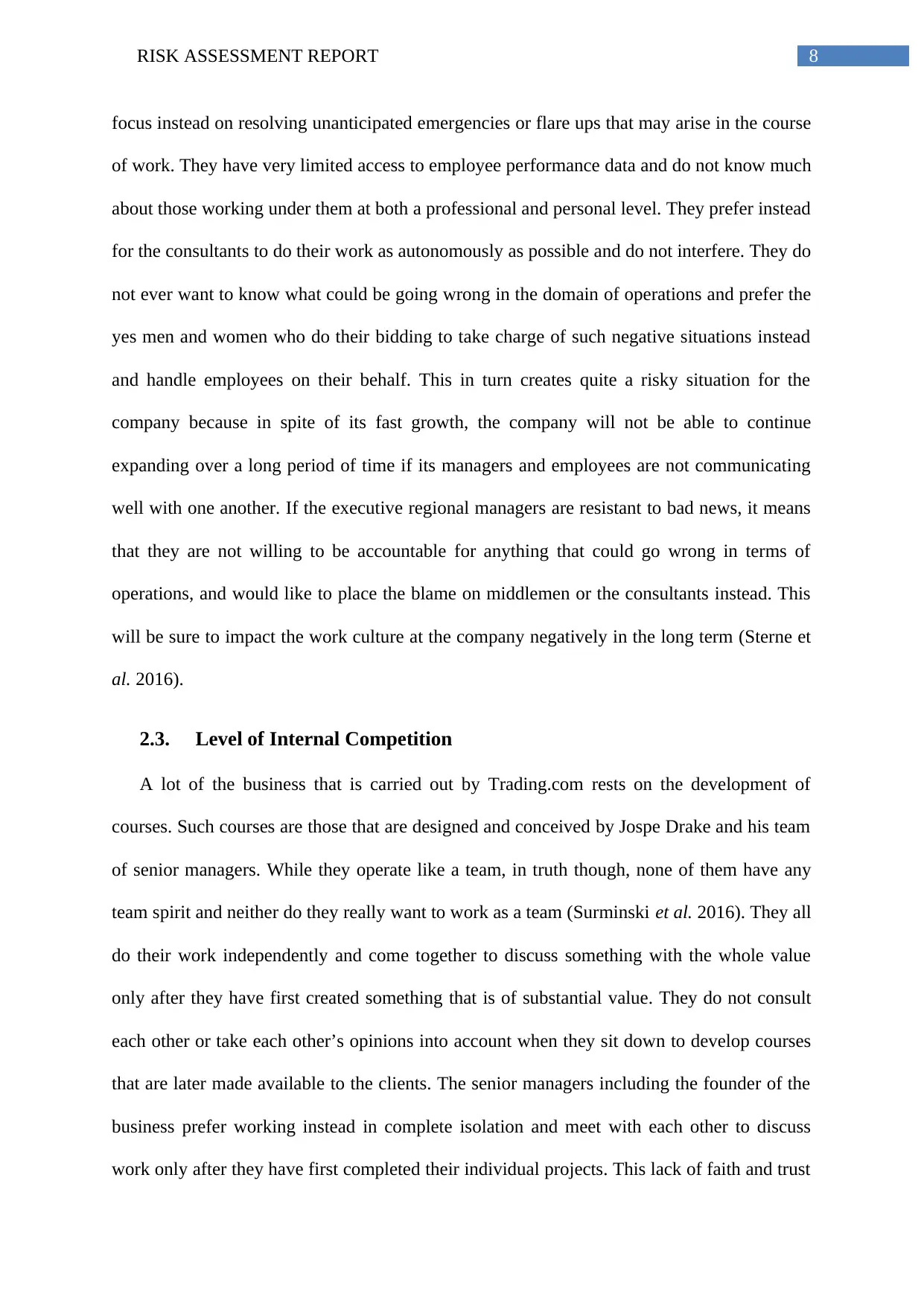
8RISK ASSESSMENT REPORT
focus instead on resolving unanticipated emergencies or flare ups that may arise in the course
of work. They have very limited access to employee performance data and do not know much
about those working under them at both a professional and personal level. They prefer instead
for the consultants to do their work as autonomously as possible and do not interfere. They do
not ever want to know what could be going wrong in the domain of operations and prefer the
yes men and women who do their bidding to take charge of such negative situations instead
and handle employees on their behalf. This in turn creates quite a risky situation for the
company because in spite of its fast growth, the company will not be able to continue
expanding over a long period of time if its managers and employees are not communicating
well with one another. If the executive regional managers are resistant to bad news, it means
that they are not willing to be accountable for anything that could go wrong in terms of
operations, and would like to place the blame on middlemen or the consultants instead. This
will be sure to impact the work culture at the company negatively in the long term (Sterne et
al. 2016).
2.3. Level of Internal Competition
A lot of the business that is carried out by Trading.com rests on the development of
courses. Such courses are those that are designed and conceived by Jospe Drake and his team
of senior managers. While they operate like a team, in truth though, none of them have any
team spirit and neither do they really want to work as a team (Surminski et al. 2016). They all
do their work independently and come together to discuss something with the whole value
only after they have first created something that is of substantial value. They do not consult
each other or take each other’s opinions into account when they sit down to develop courses
that are later made available to the clients. The senior managers including the founder of the
business prefer working instead in complete isolation and meet with each other to discuss
work only after they have first completed their individual projects. This lack of faith and trust
focus instead on resolving unanticipated emergencies or flare ups that may arise in the course
of work. They have very limited access to employee performance data and do not know much
about those working under them at both a professional and personal level. They prefer instead
for the consultants to do their work as autonomously as possible and do not interfere. They do
not ever want to know what could be going wrong in the domain of operations and prefer the
yes men and women who do their bidding to take charge of such negative situations instead
and handle employees on their behalf. This in turn creates quite a risky situation for the
company because in spite of its fast growth, the company will not be able to continue
expanding over a long period of time if its managers and employees are not communicating
well with one another. If the executive regional managers are resistant to bad news, it means
that they are not willing to be accountable for anything that could go wrong in terms of
operations, and would like to place the blame on middlemen or the consultants instead. This
will be sure to impact the work culture at the company negatively in the long term (Sterne et
al. 2016).
2.3. Level of Internal Competition
A lot of the business that is carried out by Trading.com rests on the development of
courses. Such courses are those that are designed and conceived by Jospe Drake and his team
of senior managers. While they operate like a team, in truth though, none of them have any
team spirit and neither do they really want to work as a team (Surminski et al. 2016). They all
do their work independently and come together to discuss something with the whole value
only after they have first created something that is of substantial value. They do not consult
each other or take each other’s opinions into account when they sit down to develop courses
that are later made available to the clients. The senior managers including the founder of the
business prefer working instead in complete isolation and meet with each other to discuss
work only after they have first completed their individual projects. This lack of faith and trust
⊘ This is a preview!⊘
Do you want full access?
Subscribe today to unlock all pages.

Trusted by 1+ million students worldwide
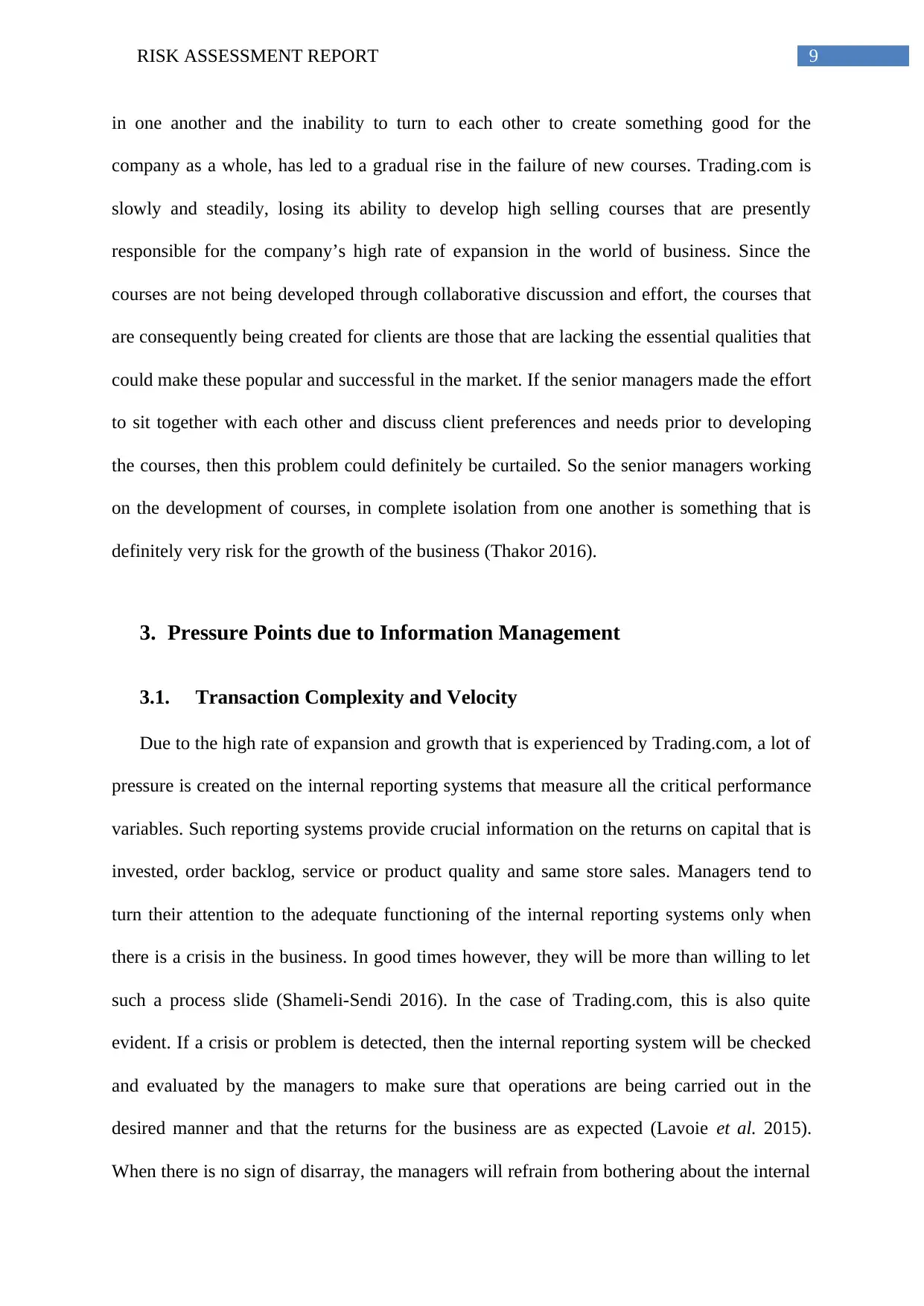
9RISK ASSESSMENT REPORT
in one another and the inability to turn to each other to create something good for the
company as a whole, has led to a gradual rise in the failure of new courses. Trading.com is
slowly and steadily, losing its ability to develop high selling courses that are presently
responsible for the company’s high rate of expansion in the world of business. Since the
courses are not being developed through collaborative discussion and effort, the courses that
are consequently being created for clients are those that are lacking the essential qualities that
could make these popular and successful in the market. If the senior managers made the effort
to sit together with each other and discuss client preferences and needs prior to developing
the courses, then this problem could definitely be curtailed. So the senior managers working
on the development of courses, in complete isolation from one another is something that is
definitely very risk for the growth of the business (Thakor 2016).
3. Pressure Points due to Information Management
3.1. Transaction Complexity and Velocity
Due to the high rate of expansion and growth that is experienced by Trading.com, a lot of
pressure is created on the internal reporting systems that measure all the critical performance
variables. Such reporting systems provide crucial information on the returns on capital that is
invested, order backlog, service or product quality and same store sales. Managers tend to
turn their attention to the adequate functioning of the internal reporting systems only when
there is a crisis in the business. In good times however, they will be more than willing to let
such a process slide (Shameli-Sendi 2016). In the case of Trading.com, this is also quite
evident. If a crisis or problem is detected, then the internal reporting system will be checked
and evaluated by the managers to make sure that operations are being carried out in the
desired manner and that the returns for the business are as expected (Lavoie et al. 2015).
When there is no sign of disarray, the managers will refrain from bothering about the internal
in one another and the inability to turn to each other to create something good for the
company as a whole, has led to a gradual rise in the failure of new courses. Trading.com is
slowly and steadily, losing its ability to develop high selling courses that are presently
responsible for the company’s high rate of expansion in the world of business. Since the
courses are not being developed through collaborative discussion and effort, the courses that
are consequently being created for clients are those that are lacking the essential qualities that
could make these popular and successful in the market. If the senior managers made the effort
to sit together with each other and discuss client preferences and needs prior to developing
the courses, then this problem could definitely be curtailed. So the senior managers working
on the development of courses, in complete isolation from one another is something that is
definitely very risk for the growth of the business (Thakor 2016).
3. Pressure Points due to Information Management
3.1. Transaction Complexity and Velocity
Due to the high rate of expansion and growth that is experienced by Trading.com, a lot of
pressure is created on the internal reporting systems that measure all the critical performance
variables. Such reporting systems provide crucial information on the returns on capital that is
invested, order backlog, service or product quality and same store sales. Managers tend to
turn their attention to the adequate functioning of the internal reporting systems only when
there is a crisis in the business. In good times however, they will be more than willing to let
such a process slide (Shameli-Sendi 2016). In the case of Trading.com, this is also quite
evident. If a crisis or problem is detected, then the internal reporting system will be checked
and evaluated by the managers to make sure that operations are being carried out in the
desired manner and that the returns for the business are as expected (Lavoie et al. 2015).
When there is no sign of disarray, the managers will refrain from bothering about the internal
Paraphrase This Document
Need a fresh take? Get an instant paraphrase of this document with our AI Paraphraser
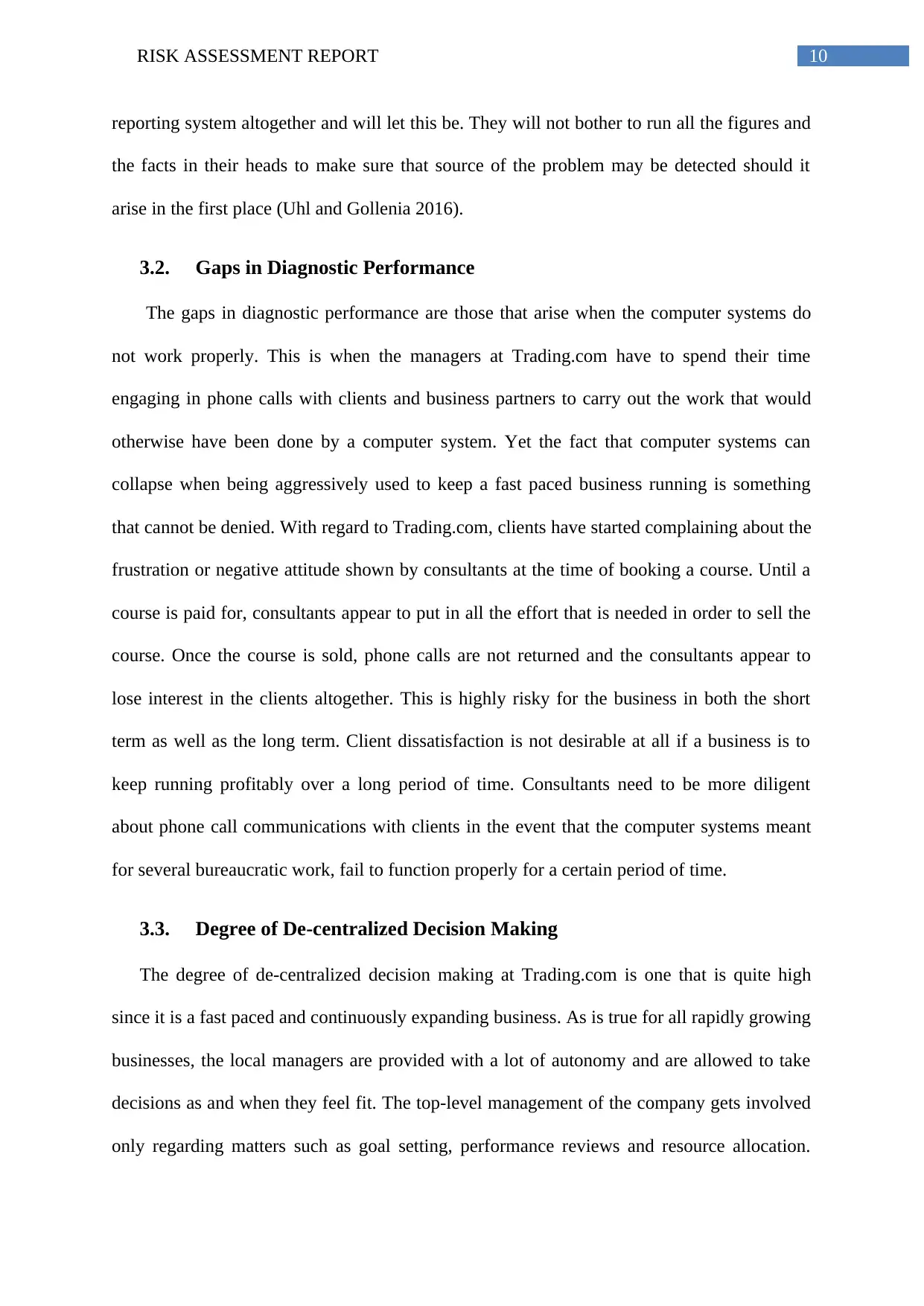
10RISK ASSESSMENT REPORT
reporting system altogether and will let this be. They will not bother to run all the figures and
the facts in their heads to make sure that source of the problem may be detected should it
arise in the first place (Uhl and Gollenia 2016).
3.2. Gaps in Diagnostic Performance
The gaps in diagnostic performance are those that arise when the computer systems do
not work properly. This is when the managers at Trading.com have to spend their time
engaging in phone calls with clients and business partners to carry out the work that would
otherwise have been done by a computer system. Yet the fact that computer systems can
collapse when being aggressively used to keep a fast paced business running is something
that cannot be denied. With regard to Trading.com, clients have started complaining about the
frustration or negative attitude shown by consultants at the time of booking a course. Until a
course is paid for, consultants appear to put in all the effort that is needed in order to sell the
course. Once the course is sold, phone calls are not returned and the consultants appear to
lose interest in the clients altogether. This is highly risky for the business in both the short
term as well as the long term. Client dissatisfaction is not desirable at all if a business is to
keep running profitably over a long period of time. Consultants need to be more diligent
about phone call communications with clients in the event that the computer systems meant
for several bureaucratic work, fail to function properly for a certain period of time.
3.3. Degree of De-centralized Decision Making
The degree of de-centralized decision making at Trading.com is one that is quite high
since it is a fast paced and continuously expanding business. As is true for all rapidly growing
businesses, the local managers are provided with a lot of autonomy and are allowed to take
decisions as and when they feel fit. The top-level management of the company gets involved
only regarding matters such as goal setting, performance reviews and resource allocation.
reporting system altogether and will let this be. They will not bother to run all the figures and
the facts in their heads to make sure that source of the problem may be detected should it
arise in the first place (Uhl and Gollenia 2016).
3.2. Gaps in Diagnostic Performance
The gaps in diagnostic performance are those that arise when the computer systems do
not work properly. This is when the managers at Trading.com have to spend their time
engaging in phone calls with clients and business partners to carry out the work that would
otherwise have been done by a computer system. Yet the fact that computer systems can
collapse when being aggressively used to keep a fast paced business running is something
that cannot be denied. With regard to Trading.com, clients have started complaining about the
frustration or negative attitude shown by consultants at the time of booking a course. Until a
course is paid for, consultants appear to put in all the effort that is needed in order to sell the
course. Once the course is sold, phone calls are not returned and the consultants appear to
lose interest in the clients altogether. This is highly risky for the business in both the short
term as well as the long term. Client dissatisfaction is not desirable at all if a business is to
keep running profitably over a long period of time. Consultants need to be more diligent
about phone call communications with clients in the event that the computer systems meant
for several bureaucratic work, fail to function properly for a certain period of time.
3.3. Degree of De-centralized Decision Making
The degree of de-centralized decision making at Trading.com is one that is quite high
since it is a fast paced and continuously expanding business. As is true for all rapidly growing
businesses, the local managers are provided with a lot of autonomy and are allowed to take
decisions as and when they feel fit. The top-level management of the company gets involved
only regarding matters such as goal setting, performance reviews and resource allocation.
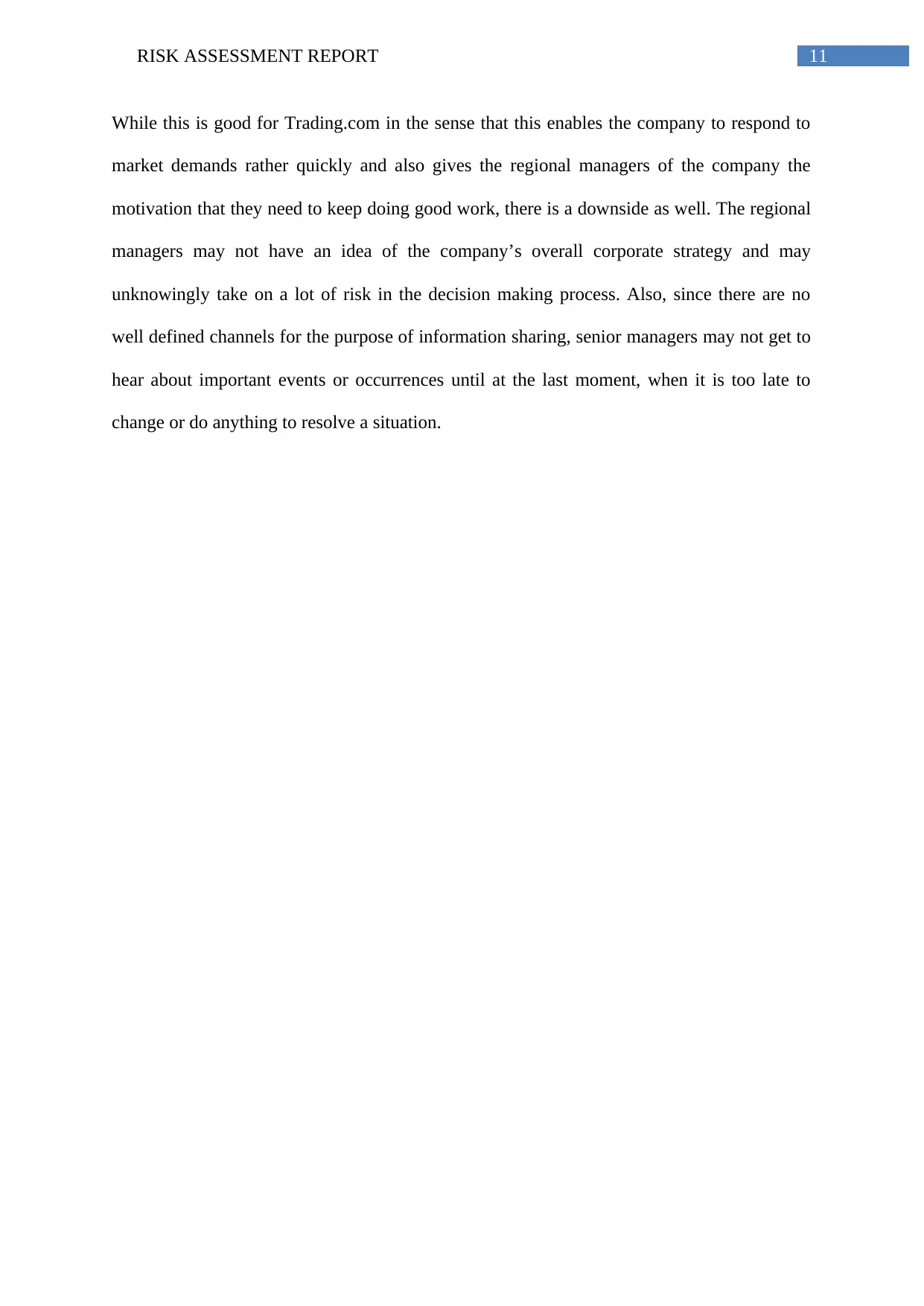
11RISK ASSESSMENT REPORT
While this is good for Trading.com in the sense that this enables the company to respond to
market demands rather quickly and also gives the regional managers of the company the
motivation that they need to keep doing good work, there is a downside as well. The regional
managers may not have an idea of the company’s overall corporate strategy and may
unknowingly take on a lot of risk in the decision making process. Also, since there are no
well defined channels for the purpose of information sharing, senior managers may not get to
hear about important events or occurrences until at the last moment, when it is too late to
change or do anything to resolve a situation.
While this is good for Trading.com in the sense that this enables the company to respond to
market demands rather quickly and also gives the regional managers of the company the
motivation that they need to keep doing good work, there is a downside as well. The regional
managers may not have an idea of the company’s overall corporate strategy and may
unknowingly take on a lot of risk in the decision making process. Also, since there are no
well defined channels for the purpose of information sharing, senior managers may not get to
hear about important events or occurrences until at the last moment, when it is too late to
change or do anything to resolve a situation.
⊘ This is a preview!⊘
Do you want full access?
Subscribe today to unlock all pages.

Trusted by 1+ million students worldwide
1 out of 15
Related Documents
Your All-in-One AI-Powered Toolkit for Academic Success.
+13062052269
info@desklib.com
Available 24*7 on WhatsApp / Email
![[object Object]](/_next/static/media/star-bottom.7253800d.svg)
Unlock your academic potential
Copyright © 2020–2025 A2Z Services. All Rights Reserved. Developed and managed by ZUCOL.




